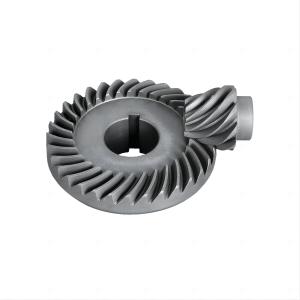A spiral bevel gear is a type of bevel gear that has curved teeth
cut in a spiral pattern around the face of the gear. These gears
are used to transmit power and motion between non-parallel
intersecting axes.
The product features of spiral bevel gears are:
1. Tooth shape: Spiral bevel gears have curved teeth cut into a
spiral shape. The curvature of the teeth allows for smoother
meshing and reduced noise compared to straight bevel gears. The
teeth are also tapered, which helps distribute load evenly across
the gear face.
2. Axial thrust: Spiral bevel gears produce axial thrust due to the
helix angle of the teeth. This axial thrust can be managed by using
thrust bearings or by designing a gear system to counteract the
thrust.
3. High load carrying capacity: Spiral bevel gears have high load
carrying capacity due to their larger contact area compared to
straight bevel gears. The helical tooth design allows for greater
tooth engagement, resulting in improved load distribution and
higher torque transfer capabilities.
4. Efficiency: The helical tooth structure of these gears increases
the overall efficiency of the gear system. Progressive tooth
engagement and engagement reduce friction and minimize power loss,
thereby improving transmission efficiency.
5. Noise and vibration: Compared with straight bevel gears, spiral
bevel gears produce less noise and vibration. The helical tooth
design helps reduce shock and noise during gear meshing, resulting
in quieter operation.
Processing features:
1. DH precision manufacturing: Spiral bevel gears require precision
manufacturing processes due to their complex tooth geometry. Gear
teeth are typically produced using specialized cutting tools, such
as spiral bevel gear generators or CNC machines. The accuracy of
the cutting process directly affects the performance and durability
of the gear.
2. Gear grinding: After the initial cutting process, spiral bevel
gears often need to be ground. Grinding helps improve gear tooth
surface finish, accuracy and tooth-to-tooth contact. Ensure correct
gear meshing to reduce noise and vibration during operation.
3. Heat treatment: Heat treatment is an essential step in
processing spiral bevel gears. It involves heating the gear to a
specific temperature and then quenching it to achieve the required
hardness and strength. Heat treatment helps improve gear durability
and wear resistance.
4. Inspection and Quality Control: Due to the critical nature of
spiral bevel gears, strict inspection and quality control
procedures are adopted during their manufacturing process. In order
to ensure the dimensional accuracy and tooth profile consistency of
the gears, we use various measurement methods, such as
three-dimensional coordinate measuring machines (CMM).
Advanced manufacturing equipment
DH has multiple CNC 7-axis 5-linkage spiral bevel gear grinding
machines and gear milling machines that can process high-reduction
ratio hypoid and transverse cured tooth coupling.
Advanced testing equipment
Utilize a high-precision gear measurement center to complete gear
pitch accuracy detection, tooth profile error detection and inverse
correction of tooth profile errors.
Professional software
Our factory has a complete set of software to realize digital
closed-loop manufacturing of spiral bevel gears, Functions such as
gear design, strength calculation, contact analysis, tool
calculation, tooth profile error reversal, etc. can be realized.
Machining methods include five tools machining(fixed setting) &
G-plete of tapper , spiral format tilt(SFT) method & hypoid
format tilt (HFT) method of Cycloid equidep, etc.


